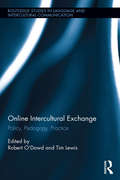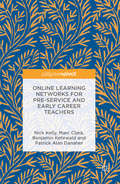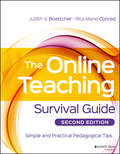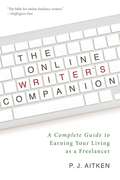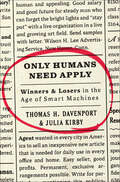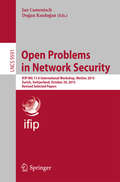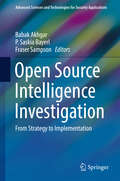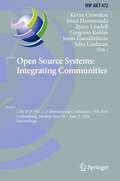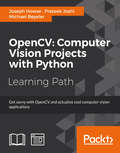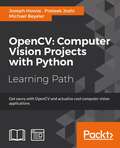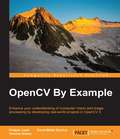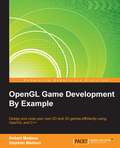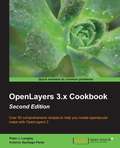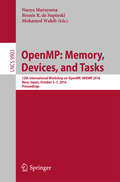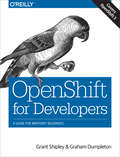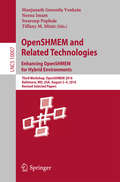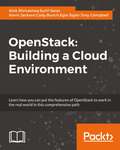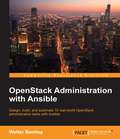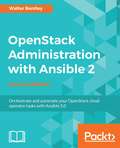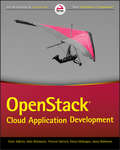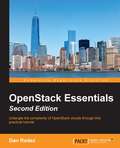- Table View
- List View
Online Intercultural Exchange: Policy, Pedagogy, Practice (Routledge Studies in Language and Intercultural Communication #15)
by Tim Lewis Robert O'DowdThis volume provides a state of the art overview of Online Intercultural Exchange (OIE) in university education and demonstrates how educators can use OIE to address current challenges in university contexts such as internationalisation, virtual mobility and intercultural foreign language education. Since the 1990s, educators have been using virtual interaction to bring their classes into contact with geographically distant partner classes to create opportunities for authentic communication, meaningful collaboration and first-hand experience of working and learning with partners from other cultural backgrounds. Online exchange projects of this nature can contribute to the development of learner autonomy, linguistic accuracy, intercultural awareness, intercultural skills and electronic literacies. Online Intercultural Exchange has now reached a stage where it is moving beyond individual classroom initiatives and is assuming a role as a major tool for internationalization, intercultural development and virtual mobility in universities around the globe. This volume reports qualitative and quantitative findings on the impact of OIE on universities in Europe and elsewhere and offers comprehensive guidance on using OIE at both pedagogical and technological levels. It provides theoretically-informed accounts of Online Intercultural Exchanges which will relevant to researchers in Computer Assisted Language Learning, Computer-Mediated Communication, or Virtual Education. Finally, contributors offer a collection of practitioner-authored and practically-oriented case studies for the benefit of teachers of foreign languages or in other subject areas who wish to engage in developing the digital literacy and intercultural competences of their learners.
Online Learning Networks for Pre-Service and Early Career Teachers
by Nick Kelly Marc Clarà Benjamin Kehrwald Patrick Alan Alan DanaherHow can we improve support for teachers as they negotiate the pathways into the profession? This books highlights how strong networks of connections with other teachers and with resources have been shown to make a big difference. Online learning networks are one way to help pre-service and early career teachers to foster these connections and the greater community of teachers has an interest in helping new teachers to enter the profession. New technologies have allowed teachers to be connected anywhere, anytime; this book discusses principles for the design and implementation of learning networks that can use this connectivity to improve support for beginning teachers. It addresses foundational principles of types of teacher communities (online and offline), types of knowledge relevant to beginning teachers, the idea of presence within a network and methodologies for studying and nurturing communities of teachers, providing recent examples of each.
Online Marketing for Busy Authors
by Fauzia Burke S. C. GwynneIf You Want People to Read Your Book, Writing It Is Only the BeginningThere has truly never been a better time to be an author. For the first time, authors have direct access to the public via the Internet--and can create a community eagerly awaiting their book. But where do new authors start? How do they sort through the dizzying range of online options? Where should they spend their time online and what should they be doing?Enter Fauzia Burke, a digital book marketing pioneer and friend of overwhelmed writers everywhere. She takes authors step-by-step through the process of identifying their unique personal brand, defining their audience, clarifying their aspirations and goals, and setting priorities. She offers advice on designing a successful website, building a mailing list of superfans, blogging, creating an engagement strategy for social media, and more. By following Burke's expert advice, authors can conquer the Internet and still get their next manuscript in on time.
The Online Teaching Survival Guide: Simple and Practical Pedagogical Tips
by Judith V. Boettcher Rita-Marie ConradEssential reading for online instructors, updated to cover new and emerging issues and technologies The Online Teaching Survival Guide provides a robust overview of theory-based techniques for teaching online or technology-enhanced courses. Covering all aspects of online teaching, this book reviews the latest research in cognitive processing and related learning outcomes while retaining a focus on the practical. A simple framework of instructional strategies mapped across a four-phase timeline provides a concrete starting point for both new online teachers and experienced teachers designing or revamping an online course. Essential technologies are explored in their basic and expanded forms, and traditional pedagogy serves as the foundation for tips and practices customized for online learning. The tips cover course management, social presence, community building, integration of new technologies, discussion and questioning techniques, assessment, and debriefing, along with new coverage of intensive or accelerated courses, customizing learning strategies, developing expertise, advanced course design, and assessment techniques exclusive to this new second edition. The theory and techniques of successful online teaching can be significantly different from those used face-to-face. With more and more classes being offered online, this book provides a valuable resource for taking your course to the next level. Understand the technology used in online teaching Learn specialized pedagogical tips and practices Examine new research on cognition and learning Adopt a clear framework of instructional strategies The explosion of online learning has created a demand for great online teachers. Increasingly, faculty who normally teach face-to-face are being asked to cover online courses—yet comprehensive pedagogical resources are scarce. The learning curve is huge, and faculty need a practical approach to course design and management that can be quickly and easily implemented. The Online Teaching Survival Guide provides that essential resource, with a customizable framework and deeper exploration of effective online teaching.
Online-Verkauf. Wie man mit dem Verkauf auf eBay, Amazon, Fiverr und Etsy Geld verdient
by Tetyana Schindler Nick Vulich"Online-Verkauf" ist deine schrittweise Anleitung zum E-Commerce-Erfolg. Dieses Buch stellt dir die großen vier Online-Plattformen vor: eBay, Amazon, Fiverr und Etsy. Möchtest du lernen, wie man online verkauft? Der Autor, Nick Vulich, hat in den letzten vierzehn Jahren über 29.000 Transaktionen auf eBay abgeschlossen. Er kennt alle Details des Verkaufs auf eBay, Amazon und Fiverr in- und auswendig und bietet dir an, dich bei der Hand zu nehmen und durch den Verkaufsprozess zu führen. Bist du neu beim E-Commerce? Schlägst du dich gerade mit dem Versuch herum, zu entscheiden, wie du loslegen kannst? Nur keine Panik. Dieses Buch wird dich durch alles führen, was du wissen musst, um noch heute mit dem Online-Verkauf zu beginnen. Jeder träumt davon, online Geld zu verdienen. Wer hätte nicht gerne einen Job, bei dem man zu Hause im Schlafanzug oder in Unterwäsche arbeiten kann? Einen Job, wo du keinen Chef hast, der dir auf die Nerven geht und dir sagt, was, wie oder wann du etwas zu tun hast? Online-Verkauf kann all das und vieles mehr sein. Entgegen der weitverbreiteten Meinung ist es aber nicht so einfach. Du wirst zwar keinen Chef haben, der dich nervt und dir sagt, was du zu tun hast, aber du wirst härter arbeiten müssen als du es jemals in deiner normalen Arbeit getan hast. Du wirst knapp bei Kasse sein, besonders am Anfang. Nur weil du beschließt, deine Waren auf eBay, Amazon oder irgendeiner anderen Webseite anzupreisen, bedeutet das noch lange nicht, dass Käufer wie durch Zauberhand zu deinen Artikeln strömen und dich mit Geld überhäufen werden. Wie alles andere braucht ein erfolgreicher Verkauf von Produkten oder Dienstleistungen online seine Zeit. Jeder kann online Artikel auflisten und ein paar schnelle Verkäufe erzielen. Um jedoch ein erfolgreicher Online-Verkäufer zu sein, muss man diesen Prozess tagtäglich und Monat für Monat wiederholen.
The Online Writer?s Companion: A Complete Guide to Earning Your Living as a Freelancer
by P. J. AitkenEvery year, millions of writers struggle to find work, and most make little more than spare change from the assignments they land. With the expansion of the online freelance marketplace, anyone with the right skills can learn to thrive and build a full-time career as a freelance writer. Author P. J. Aitken shares with readers what those skills are-the same skills that have earned him high levels of success on Upwork and other online freelance platforms. His tips include:Creating the perfect profileWriting winning proposals when bidding on writing jobsGarnering the rating system that will bring recognition and new clientsEstablishing long-term clientsOutsourcing for the most efficient resultsBlogging-for pay!Navigating the best sites and avoiding pitfalls many writers fall intoThe Online Writer’s Companion is an unprecedented and indispensable guide for aspiring writers and authors of various materials and backgrounds, from bloggers to professional writers, students to retirees. It can even touch freelancers in other trades who want to hone their skills. By learning to make the most of a myriad of websites for freelance writers, readers will finally have the knowledge to succeed!Allworth Press, an imprint of Skyhorse Publishing, publishes a broad range of books on the visual and performing arts, with emphasis on the business of art. Our titles cover subjects such as graphic design, theater, branding, fine art, photography, interior design, writing, acting, film, how to start careers, business and legal forms, business practices, and more. While we don't aspire to publish a New York Times bestseller or a national bestseller, we are deeply committed to quality books that help creative professionals succeed and thrive. We often publish in areas overlooked by other publishers and welcome the author whose expertise can help our audience of readers.
Only Humans Need Apply: Winners & Losers in the Age of Smart Machines
by Thomas H. Davenport Julia KirbyAn invigorating, thought-provoking, and positive look at the rise of automation that explores how professionals across industries can find sustainable careers in the near future.Nearly half of all working Americans could risk losing their jobs because of technology. It’s not only blue-collar jobs at stake. Millions of educated knowledge workers—writers, paralegals, assistants, medical technicians—are threatened by accelerating advances in artificial intelligence.The industrial revolution shifted workers from farms to factories. In the first era of automation, machines relieved humans of manually exhausting work. Today, Era Two of automation continues to wash across the entire services-based economy that has replaced jobs in agriculture and manufacturing. Era Three, and the rise of AI, is dawning. Smart computers are demonstrating they are capable of making better decisions than humans. Brilliant technologies can now decide, learn, predict, and even comprehend much faster and more accurately than the human brain, and their progress is accelerating. Where will this leave lawyers, nurses, teachers, and editors?In Only Humans Need Apply, Thomas Hayes Davenport and Julia Kirby reframe the conversation about automation, arguing that the future of increased productivity and business success isn’t either human or machine. It’s both. The key is augmentation, utilizing technology to help humans work better, smarter, and faster. Instead of viewing these machines as competitive interlopers, we can see them as partners and collaborators in creative problem solving as we move into the next era. The choice is ours.
Open Problems in Network Security
by Jan Camenisch Doğan KesdoğanThis book constitutes the thoroughly refereed post-conference proceedings of the IFIP WG 11. 4 International Workshop on Open Problems in Network Security, iNetSec 2015, held in Zurich, Switzerland, in October 2015. iNetSec is the main workshop of the IFIP working group WG 11. 4; its objective is to present and discuss open problems and new research directions on all aspects related to network security. The 9 revised full papers presented in this volume were carefully reviewed and selected from 13 submissions. They were organized in topical sections named: network security; intrusion detection; anonymous communication; and cryptography.
Open Source Intelligence Investigation
by Babak Akhgar P. Saskia Bayerl Fraser SampsonOne of the most important aspects for a successful police operation is the ability for the police to obtain timely, reliable and actionable intelligence related to the investigation or incident at hand. Open Source Intelligence (OSINT) provides an invaluable avenue to access and collect such information in addition to traditional investigative techniques and information sources. This book offers an authoritative and accessible guide on how to conduct Open Source Intelligence investigations from data collection to analysis to the design and vetting of OSINT tools. In its pages the reader will find a comprehensive view into the newest methods for OSINT analytics and visualizations in combination with real-life case studies to showcase the application as well as the challenges of OSINT investigations across domains. Examples of OSINT range from information posted on social media as one of the most openly available means of accessing and gathering Open Source Intelligence to location data, OSINT obtained from the darkweb to combinations of OSINT with real-time analytical capabilities and closed sources. In addition it provides guidance on legal and ethical considerations making it relevant reading for practitioners as well as academics and students with a view to obtain thorough, first-hand knowledge from serving experts in the field.
Open Source Intelligence Investigation: From Strategy to Implementation (Advanced Sciences and Technologies for Security Applications)
by Babak Akhgar, P. Saskia Bayerl and Fraser SampsonOne of the most important aspects for a successful police operation is the ability for the police to obtain timely, reliable and actionable intelligence related to the investigation or incident at hand. Open Source Intelligence (OSINT) provides an invaluable avenue to access and collect such information in addition to traditional investigative techniques and information sources. This book offers an authoritative and accessible guide on how to conduct Open Source Intelligence investigations from data collection to analysis to the design and vetting of OSINT tools. In its pages the reader will find a comprehensive view into the newest methods for OSINT analytics and visualizations in combination with real-life case studies to showcase the application as well as the challenges of OSINT investigations across domains. Examples of OSINT range from information posted on social media as one of the most openly available means of accessing and gathering Open Source Intelligence to location data, OSINT obtained from the darkweb to combinations of OSINT with real-time analytical capabilities and closed sources. In addition it provides guidance on legal and ethical considerations making it relevant reading for practitioners as well as academics and students with a view to obtain thorough, first-hand knowledge from serving experts in the field.
Open Source Systems: Integrating Communities
by Kevin Crowston Imed Hammouda Björn Lundell Gregorio Robles Jonas Gamalielsson Juho LindmanThis book constitutes the refereed proceedings of the 12th International IFIP WG 2. 13 International Conference on Open Source Systems, OSS 2016, held in Gothenburg, Sweden, in May/June 2016. The 13 revised full papers presented were carefully reviewed and selected from 38 submissions. The papers cover a wide range of topics related to free, libre, and open source software, including: organizational aspects of communities; organizational adoption; participation of women; software maintenance and evolution; open standards and open data; collaboration; hybrid communities; code reviews; and certification.
Open Source Systems: 12th IFIP WG 2.13 International Conference, OSS 2016, Gothenburg, Sweden, May 30 - June 2, 2016, Proceedings (IFIP Advances in Information and Communication Technology #472)
by Kevin Crowston Imed Hammouda Björn Lundell Gregorio Robles Jonas Gamalielsson Juho LindmanThis book constitutes the refereed proceedings of the 12th International IFIP WG 2.13 International Conference on Open Source Systems, OSS 2016, held in Gothenburg, Sweden, in May/June 2016. The 13 revised full papers presented were carefully reviewed and selected from 38 submissions. The papers cover a wide range of topics related to free, libre, and open source software, including: organizational aspects of communities; organizational adoption; participation of women; software maintenance and evolution; open standards and open data; collaboration; hybrid communities; code reviews; and certification.
OpenCV: Computer Vision Projects with Python
by Prateek Joshi Joseph Howse Michael BeyelerGet savvy with OpenCV and actualize cool computer vision applications About This Book * Use OpenCV's Python bindings to capture video, manipulate images, and track objects * Learn about the different functions of OpenCV and their actual implementations. * Develop a series of intermediate to advanced projects using OpenCV and Python Who This Book Is For This learning path is for someone who has a working knowledge of Python and wants to try out OpenCV. This Learning Path will take you from a beginner to an expert in computer vision applications using OpenCV. OpenCV's application are humongous and this Learning Path is the best resource to get yourself acquainted thoroughly with OpenCV. What You Will Learn * Install OpenCV and related software such as Python, NumPy, SciPy, OpenNI, and SensorKinect - all on Windows, Mac or Ubuntu * Apply "curves" and other color transformations to simulate the look of old photos, movies, or video games * Apply geometric transformations to images, perform image filtering, and convert an image into a cartoon-like image * Recognize hand gestures in real time and perform hand-shape analysis based on the output of a Microsoft Kinect sensor * Reconstruct a 3D real-world scene from 2D camera motion and common camera reprojection techniques * Detect and recognize street signs using a cascade classifier and support vector machines (SVMs) * Identify emotional expressions in human faces using convolutional neural networks (CNNs) and SVMs * Strengthen your OpenCV2 skills and learn how to use new OpenCV3 features In Detail OpenCV is a state-of-art computer vision library that allows a great variety of image and video processing operations. OpenCV for Python enables us to run computer vision algorithms in real time. This learning path proposes to teach the following topics. First, we will learn how to get started with OpenCV and OpenCV3's Python API, and develop a computer vision application that tracks body parts. Then, we will build amazing intermediate-level computer vision applications such as making an object disappear from an image, identifying different shapes, reconstructing a 3D map from images , and building an augmented reality application, Finally, we'll move to more advanced projects such as hand gesture recognition, tracking visually salient objects, as well as recognizing traffic signs and emotions on faces using support vector machines and multi-layer perceptrons respectively. This Learning Path combines some of the best that Packt has to offer in one complete, curated package. It includes content from the following Packt products: * OpenCV Computer Vision with Python by Joseph Howse * OpenCV with Python By Example by Prateek Joshi * OpenCV with Python Blueprints by Michael Beyeler Style and approach This course aims to create a smooth learning path that will teach you how to get started with will learn how to get started with OpenCV and OpenCV 3's Python API, and develop superb computer vision applications. Through this comprehensive course, you'll learn to create computer vision applications from scratch to finish and more!.
OpenCV: Computer Vision Projects with Python
by Joseph Howse Prateek Joshi Michael Beyeler<P><P>About This Book <P><P>Use OpenCV's Python bindings to capture video, manipulate images, and track objects <P><P>Learn about the different functions of OpenCV and their actual implementations. <P><P>Develop a series of intermediate to advanced projects using OpenCV and Python <P><P>Who This Book Is For <P><P>This learning path is for someone who has a working knowledge of Python and wants to try out OpenCV. This Learning Path will take you from a beginner to an expert in computer vision applications using OpenCV. OpenCV's application are humongous and this Learning Path is the best resource to get yourself acquainted thoroughly with OpenCV. <P><P>What You Will Learn <P><P>Install OpenCV and related software such as Python, NumPy, SciPy, OpenNI, and SensorKinect - all on Windows, Mac or Ubuntu <P><P>Apply "curves" and other color transformations to simulate the look of old photos, movies, or video games <P><P>Apply geometric transformations to images, perform image filtering, and convert an image into a cartoon-like image <P><P>Recognize hand gestures in real time and perform hand-shape analysis based on the output of a Microsoft Kinect sensor <P><P>Reconstruct a 3D real-world scene from 2D camera motion and common camera reprojection techniques <P><P>Detect and recognize street signs using a cascade classifier and support vector machines (SVMs) <P><P>Identify emotional expressions in human faces using convolutional neural networks (CNNs) and SVMs <P><P>Strengthen your OpenCV2 skills and learn how to use new OpenCV3 features <P><P>In Detail <P><P>OpenCV is a state-of-art computer vision library that allows a great variety of image and video processing operations. OpenCV for Python enables us to run computer vision algorithms in real time. This learning path proposes to teach the following topics. First, we will learn how to get started with OpenCV and OpenCV3's Python API, and develop a computer vision application that tracks body parts. Then, we will build amazing intermediate-level computer vision applications such as making an object disappear from an image, identifying different shapes, reconstructing a 3D map from images , and building an augmented reality application, Finally, we'll move to more advanced projects such as hand gesture recognition, tracking visually salient objects, as well as recognizing traffic signs and emotions on faces using support vector machines and multi-layer perceptrons respectively. <P><P>This Learning Path combines some of the best that Packt has to offer in one complete, curated package. It includes content from the following Packt products:
OpenCV By Example
by Vinicius Godoy David Millan Escriva Prateek JoshiEnhance your understanding of Computer Vision and image processing by developing real-world projects in OpenCV 3 About This Book * Get to grips with the basics of Computer Vision and image processing * This is a step-by-step guide to developing several real-world Computer Vision projects using OpenCV 3 * This book takes a special focus on working with Tesseract OCR, a free, open-source library to recognize text in images Who This Book Is For If you are a software developer with a basic understanding of Computer Vision and image processing and want to develop interesting Computer Vision applications with Open CV, this is the book for you. Knowledge of C++ is required. What You Will Learn * Install OpenCV 3 on your operating system * Create the required CMake scripts to compile the C++ application and manage its dependencies * Get to grips with the Computer Vision workflows and understand the basic image matrix format and filters * Understand the segmentation and feature extraction techniques * Remove backgrounds from a static scene to identify moving objects for video surveillance * Track different objects in a live video using various techniques * Use the new OpenCV functions for text detection and recognition with Tesseract In Detail Open CV is a cross-platform, free-for-use library that is primarily used for real-time Computer Vision and image processing. It is considered to be one of the best open source libraries that helps developers focus on constructing complete projects on image processing, motion detection, and image segmentation. Whether you are completely new to the concept of Computer Vision or have a basic understanding of it, this book will be your guide to understanding the basic OpenCV concepts and algorithms through amazing real-world examples and projects. Starting from the installation of OpenCV on your system and understanding the basics of image processing, we swiftly move on to creating optical flow video analysis or text recognition in complex scenes, and will take you through the commonly used Computer Vision techniques to build your own Open CV projects from scratch. By the end of this book, you will be familiar with the basics of Open CV such as matrix operations, filters, and histograms, as well as more advanced concepts such as segmentation, machine learning, complex video analysis, and text recognition. Style and approach This book is a practical guide with lots of tips, and is closely focused on developing Computer vision applications with OpenCV. Beginning with the fundamentals, the complexity increases with each chapter. Sample applications are developed throughout the book that you can execute and use in your own projects.
OpenGL Game Development By Example
by Robert Madsen Stephen MadsenDesign and code your own 2D and 3D games efficiently using OpenGL and C++ About This Book * Create 2D and 3D games completely, through a series of end-to-end game projects * Learn to render high performance 2D and 3D graphics using OpenGL * Implement a rudimentary game engine using step-by-step code Who This Book Is For If you are a prospective game developer with some experience using C++, then this book is for you. Both prospective and experienced game programmers will find nuggets of wisdom and practical advice as they learn to code two full games using OpenGL, C++, and a host of related tools. What You Will Learn * Set up your development environment in Visual Studio using OpenGL * Use 2D and 3D coordinate systems * Implement an input system to handle the mouse and the keyboard * Create a state machine to handle complex changes in the game * Load, display, and manipulate both 2D and 3D graphics * Implement collision detection and basic physics * Discover the key components needed to complete a polished game * Handle audio files and implement sound effects and music In Detail OpenGL is one of the most popular rendering SDKs used to develop games. OpenGL has been used to create everything from 3D masterpieces running on desktop computers to 2D puzzles running on mobile devices. You will learn to apply both 2D and 3D technologies to bring your game idea to life. There is a lot more to making a game than just drawing pictures and that is where this book is unique! It provides a complete tutorial on designing and coding games from the setup of the development environment to final credits screen, through the creation of a 2D and 3D game. The book starts off by showing you how to set up a development environment using Visual Studio, and create a code framework for your game. It then walks you through creation of two games-a 2D platform game called Roboracer 2D and a 3D first-person space shooter game-using OpenGL to render both 2D and 3D graphics using a 2D coordinate system. You'll create sprite classes, render sprites and animation, and navigate and control the characters. You will also learn how to implement input, use audio, and code basic collision and physics systems. From setting up the development environment to creating the final credits screen, the book will take you through the complete journey of creating a game engine that you can extend to create your own games. Style and approach An easy-to-follow guide full of code examples to illustrate every concept and help you build a 2D and 3D game from scratch, while learning the key tools that surround a typical OpenGL project.
OpenLayers 3.x Cookbook - Second Edition
by Peter J. Langley Antonio Santiago PerezOver 50 comprehensive recipes to help you create spectacular maps with OpenLayers 3 About This Book * Create highly customized mapping apps for the web with rich interactivity and diverse content using JavaScript * See how successful mapping apps work and how they integrate with third-party services * Packed full of code examples, screenshots, and explanations from professionals in the industry Who This Book Is For If you are a GIS-related professional with basic knowledge of web technologies and want to gain in-depth knowledge of creating web mapping applications, then this book is for you. The recipes will be appropriately mixed to suit JavaScript beginners or experts and cover basic to advanced topics on OpenLayers. What You Will Learn * Create stunning maps, and understand projection. * Add customized raster and vector layers * Work with important tile providers * Work with OGCs, WMS, and WFS compliant servers * Read/write features from/to different data sources * Style features to improve their visualization * Understand events and work with the main controls * Enhance maps with HTML5 technologies such as Geolocation In Detail Data visualization and analytics has become an important task across all technology-based industries. OpenLayers 3,is one of the most important and complete open source JavaScript mapping libraries today. Throughout this book, you will go through recipes that expose various features of OpenLayers 3, allowing you to gain an insight into building complex GIS web applications. You'll get to grips with the basics of creating a map with common functionality and quickly advance to more complicated solutions that address modern challenges. You will explore into maps, raster and vector layers and styling in-depth. This book also includes problem solving and how-to recipes for the most common and important tasks. The range of recipes includes: creating basic maps, working with raster and vector layers, understanding events,working with the main controls, reading features from different data sources, styling features, and understanding the underlying architecture. It will also cover solutions and optimizations to challenges commonly faced in modern applications. Style and approach This book teaches you how to create stunning maps that are highly interactive and visually appealing with the help of 50 handpicked recipes. Each recipe will address your need to visualize data on a map. Just follow the steps in the recipes to create maps of your choice in no time.
OpenMP: Memory, Devices, and Tasks
by Naoya Maruyama Bronis R. Supinski Mohamed WahibThis book constitutes the proceedings of the 12th International Workshop on OpenMP, IWOMP 2016, held in Nara, Japan, in October 2016. The 24 full papers presented in this volume were carefully reviewed and selected from 28 submissions. They were organized in topical sections named: applications, locality, task parallelism, extensions, tools, accelerator programming, and performance evaluations and optimization.
OpenShift for Developers: A Guide for Impatient Beginners
by Graham Dumpleton Grant ShipleyKeen to build web applications for the cloud? Get a quick hands-on introduction to OpenShift, the open source Platform as a Service (PaaS) offering from Red Hat. With this practical guide, you’ll learn the steps necessary to build, deploy, and host a complete real-world application on OpenShift without having to slog through long, detailed explanations of the technologies involved. OpenShift enables you to use Docker application containers and the Kubernetes cluster manager to automate the way you create, ship, and run applications. Through the course of the book, you’ll learn how to use OpenShift and the Wildfly application server to build and then immediately deploy a Java application online. Learn about OpenShift’s core technology, including Docker-based containers and Kubernetes; Use a virtual machine with OpenShift installed and configured on your local environment; Create and deploy your first application on the OpenShift platform; Add language runtime dependencies and connect to a database; Trigger an automatic rebuild and redeployment when you push changes to the repository; Get a working environment up in minutes with application templates; Use commands to check and debug your application; Create and build Docker-based images for your application.
OpenSHMEM and Related Technologies. Enhancing OpenSHMEM for Hybrid Environments
by Manjunath Gorentla Venkata Neena Imam Swaroop Pophale Tiffany M. MintzThis book constitutes the proceedings of the Third OpenSHMEM Workshop, held in Baltimore, MD, USA, in August 2016. The 14 full papers and 3 short papers presented were carefully reviewed and selected from 25 submissions. The papers discuss a variety of ideas of extending the OpenSHMEM specification and making it efficient for current and next generation systems. This included active messages, non-blocking APIs, fault tolerance capabitlities, exploring implementation of OpenSHMEM using communication layers such as OFI and UCX and implementing OpenSHMEM for heterogeneous architectures.
OpenStack: Building a Cloud Environment
by Tony Campbell Kevin Jackson Alok Shrivastwa Egle Sigler Sunil Sarat Cody BunchLearn how you can put the features of OpenStack to work in the real world in this comprehensive path About This Book * Harness the abilities of experienced OpenStack administrators and architects, and run your own private cloud successfully * Learn how to install, configure, and manage all of the OpenStack core projects including topics on Object Storage, Block Storage, and Neutron Networking services such as LBaaS and FWaaS * Get better equipped to troubleshoot and solve common problems in performance, availability, and automation that confront production-ready OpenStack environments Who This Book Is For This course is for those who are new to OpenStack who want to learn the cloud networking fundamentals and get started with OpenStack networking. Basic understanding of Linux Operating System, Virtualization, and Networking, and Storage principles will come in handy. What You Will Learn * Get an introduction to OpenStack and its components * Store and retrieve data and images using storage components, such as Cinder, Swift, and Glance * Install and configure Swift, the OpenStack Object Storage service, including configuring Container Replication between datacenters * Gain hands on experience and familiarity with Horizon, the OpenStack Dashboard user interface * Learn how to automate OpenStack installations using Ansible and Foreman * Follow practical advice and examples for running OpenStack in production * Fix common issues with images served through Glance and master the art of troubleshooting Neutron networking In Detail OpenStack is a collection of software projects that work together to provide a cloud fabric. Learning OpenStack Cloud Computing course is an exquisite guide that you will need to build cloud environments proficiently. This course will help you gain a clearer understanding of OpenStack's components and their interaction with each other to build a cloud environment. The first module, Learning OpenStack, starts with a brief look into the need for authentication and authorization, the different aspects of dashboards, cloud computing fabric controllers, along with 'Networking as a Service' and 'Software defined Networking'. Then, you will focus on installing, configuring, and troubleshooting different architectures such as Keystone, Horizon, Nova, Neutron, Cinder, Swift, and Glance. After getting familiar with the fundamentals and application of OpenStack, let's move deeper into the realm of OpenStack. In the second module, OpenStack Cloud Computing Cookbook, preview how to build and operate OpenStack cloud computing, storage, networking, and automation. Dive into Neutron, the OpenStack Networking service, and get your hands dirty with configuring ML2, networks, routers, and distributed virtual routers. Further, you'll learn practical examples of Block Storage, LBaaS, and FBaaS. The final module, Troubleshooting OpenStack, will help you quickly diagnose, troubleshoot, and correct problems in your OpenStack. We will diagnose and remediate issues in Keystone, Glance, Neutron networking, Nova, Cinder block storage, Swift object storage, and issues caused by Heat orchestration. This Learning Path combines some of the best that Packt has to offer in one complete, curated package. It includes content from the following Packt products: * Learning OpenStack by Alok Shrivastwa, Sunil Sarat * OpenStack Cloud Computing Cookbook - Third Edition by Kevin Jackson , Cody Bunch, Egle Sigler * Troubleshooting OpenStack by Tony Campbell Style and approach This course aims to create a smooth learning path that will teach you how to get started with setting up private and public clouds using a free and open source cloud computing platform--OpenStack. Through this comprehensive course, you'll learn OpenStack Cloud computing from scratch to finish and more!"
OpenStack Administration with Ansible
by Walter BentleyDesign, build, and automate 10 real-world OpenStack administrative tasks with Ansible About This Book * Automate real-world OpenStack cloud operator administrative tasks * Construct a collection of automation code to save time on managing your OpenStack cloud * Use this step-by-step tutorial to automate such tasks with Ansible Who This Book Is For If you are an OpenStack-based cloud operator and/or infrastructure administrator and are interested in automating administrative functions, then this book is exactly what you are looking for. Having a functioning OpenStack environment is helpful, but most certainly not necessary. What You Will Learn * Efficiently execute OpenStack administrative tasks * Familiarize yourself with how Ansible works and assess the defined best practices * Create Ansible playbooks and roles * Automate tasks to customize your OpenStack cloud * Review OpenStack automation considerations when automating administrative tasks * Examine and automate advanced OpenStack tasks and designated use cases * Get a high-level overview of OpenStack and the current production-ready projects * Deep dive into OpenStack CLI tools and find out how to use them In Detail Most organizations are seeking methods to improve business agility because they have realized just having a cloud is not enough. Being able to improve application deployments, reduce infrastructure downtime, and eliminate daily manual tasks can only be accomplished through some sort of automation. Packed with real-world OpenStack administrative tasks, this book will walk you through working examples and explain how these tasks can be automated using one of the most popular open source automation tools--Ansible. We will start with a brief overview of OpenStack and Ansible and highlight some best practices. Each chapter will provide an introduction to handling various Cloud Operator administration tasks such as creating multiple users/tenants, setting up Multi-Tenant Isolation, customizing your clouds quotas, taking instance snapshots, evacuating compute hosts for maintenance, and running cloud health checks, and a step-by-step tutorial on how to automate these tasks with Ansible. Style and approach This easy-to-follow reference guide is packed with examples of real-world OpenStack administration tasks; each task is explained in detail and then subsequently turned into automation code.
OpenStack Administration with Ansible 2 - Second Edition
by Walter BentleyOrchestrate and automate your OpenStack cloud operator tasks with Ansible 2.0 About This Book • Automate real-world OpenStack cloud operator administrative tasks • Construct a collection of the latest automation code to save time on managing your OpenStack cloud • Manage containers on your cloud and check the health of your cloud using Nagios Who This Book Is For This book is aimed at OpenStack-based cloud operators and infrastructure and sys administrators who have some knowledge of OpenStack and are seeking to automate taxing and manual tasks. This book is also for people new to automating cloud operations in general and the DevOps practice in particular. What You Will Learn • Efficiently execute OpenStack administrative tasks • Familiarize yourself with how Ansible 2 works and assess the defined best practices • Create Ansible 2 playbooks and roles • Automate tasks to customize your OpenStack cloud • Review OpenStack automation considerations when automating administrative tasks • Examine and automate advanced OpenStack tasks and designated use cases • Get a high-level overview of OpenStack and current production-ready projects • Explore OpenStack CLI tools and learn how to use them In Detail Most organizations are seeking methods to improve business agility because they have realized just having a cloud is not enough. Being able to improve application deployments, reduce infrastructure downtime, and eliminate daily manual tasks can only be accomplished through some sort of automation. We start with a brief overview of OpenStack and Ansible 2 and highlight some best practices. Each chapter will provide an introduction to handling various Cloud Operator administration tasks such as managing containers within your cloud; setting up/utilizing open source packages for monitoring; creating multiple users/tenants; taking instance snapshots; and customizing your cloud to run multiple active regions. Each chapter will also supply a step-by-step tutorial on how to automate these tasks with Ansible 2. Packed with real-world OpenStack administrative tasks, this book will walk you through working examples and explain how these tasks can be automated using one of the most popular open source automation tools on the market today. Style and approach This book is a concise, fast-paced guide filled with real-world scenarios that will execute OpenStack administrative tasks efficiently. It serves as a quick reference guide for not just OpenStack functions, but also for creating future Ansible code.
OpenStack Cloud Application Development
by Jason E. Robinson Vincent Giersch Scott Adkins John Belamaric Denys MakogonLeverage the power of OpenStack to develop scalable applications with no vendor lock-in OpenStack Cloud Application Development is a fast-paced, professional book for OpenStack developers, delivering comprehensive guidance without wasting time on development fundamentals. Written by experts in the OpenStack community from Infoblox, Gigaspaces, GoDaddy, and Comcast, this book shows you how to work effectively and efficiently within the OpenStack platform to develop large, scalable applications without worrying about underlying hardware. Follow along with an OpenStack build that illustrates how and where each technology comes into play, as you learn expert tips and best practices that make your product stronger. Coverage includes OpenStack service primitives, networking within the OpenStack Ecosystem, deployment of Virtualized Network Functions for Enterprises, containers, data protection, and much more. If you need to get on board quickly, this professional book is your ideal roadmap to OpenStack development. Understand all aspects of OpenStack technologies Follow an example build to drill down into critical elements Learn the OpenStack best practices and insider tips Leverage the full capability of IaaS at a professional pace OpenStack is supported by dozens of major technology companies, compatible with Amazon Web Services, and can be used alongside or on top of VMWare vSphere and other similar technologies. It frees developers from the confines of hardware and vendor lock-in while providing a reliable, fast, and easy platform for developing scalable cloud applications. OpenStack Cloud Application Development is an expert-led guide to getting the most out of OpenStack, designed specifically for the professional developer.
OpenStack Essentials - Second Edition
by Dan RadezUntangle the complexity of OpenStack clouds through this practical tutorial About This Book * Navigate through the complex jungle of components in OpenStack using practical instructions * This book helps administrators, cloud engineers, and even developers to consolidate and control pools of compute, networking, and storage resources * Learn to use the centralized dashboard and administration panel to monitor large-scale deployments Who This Book Is For This book is perfect for administrators, cloud engineers, and operators who want to get started with OpenStack, solve basic problems encountered during deployment, and get up to speed with the latest release of OpenStack. Familiarity with the Linux command line and experience with Linux system administration is expected. What You Will Learn * Brush up on the latest release, and how it affects the various components * Install OpenStack using the Packstack and RDO Manager installation tool * Learn to convert a computer node that supports Docker containers * Implement Ceph Block Device images with OpenStack * Create and allocate virtual networks, routers and IP addresses to OpenStack Tenants. * Configuring and Launching a Docker container. In Detail OpenStack is a widely popular platform for cloud computing. Applications that are built for this platform are resilient to failure and convenient to scale. This book, an update to our extremely popular OpenStack Essentials (published in May 2015) will help you master not only the essential bits, but will also examine the new features of the latest OpenStack release - Mitaka; showcasing how to put them to work straight away. This book begins with the installation and demonstration of the architecture. This book will tech you the core 8 topics of OpenStack. They are Keystone for Identity Management, Glance for Image management, Neutron for network management, Nova for instance management, Cinder for Block storage, Swift for Object storage, Ceilometer for Telemetry and Heat for Orchestration. Further more you will learn about launching and configuring Docker containers and also about scaling them horizontally. You will also learn about monitoring and Troubleshooting OpenStack. Style and approach This book offers step-by-step practical instructions to help you quickly navigate through the complexities of OpenStack
